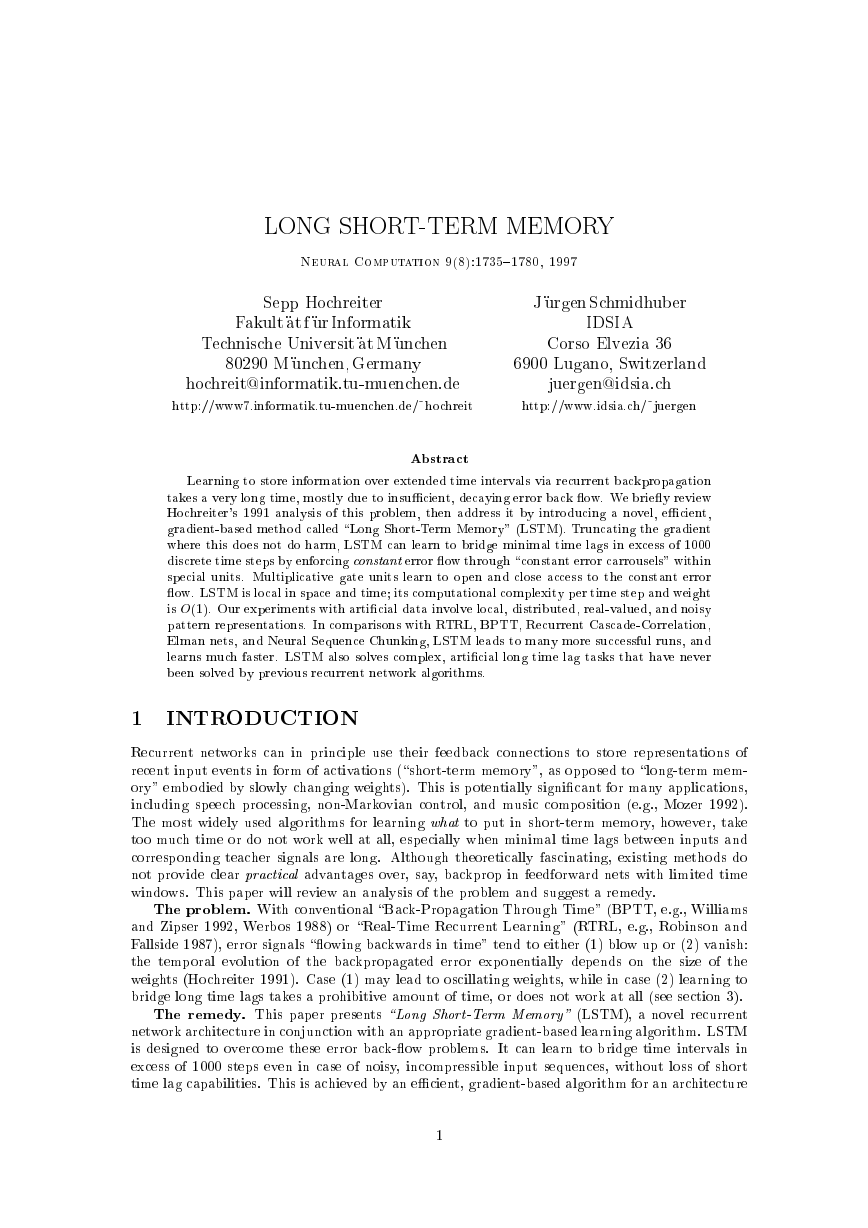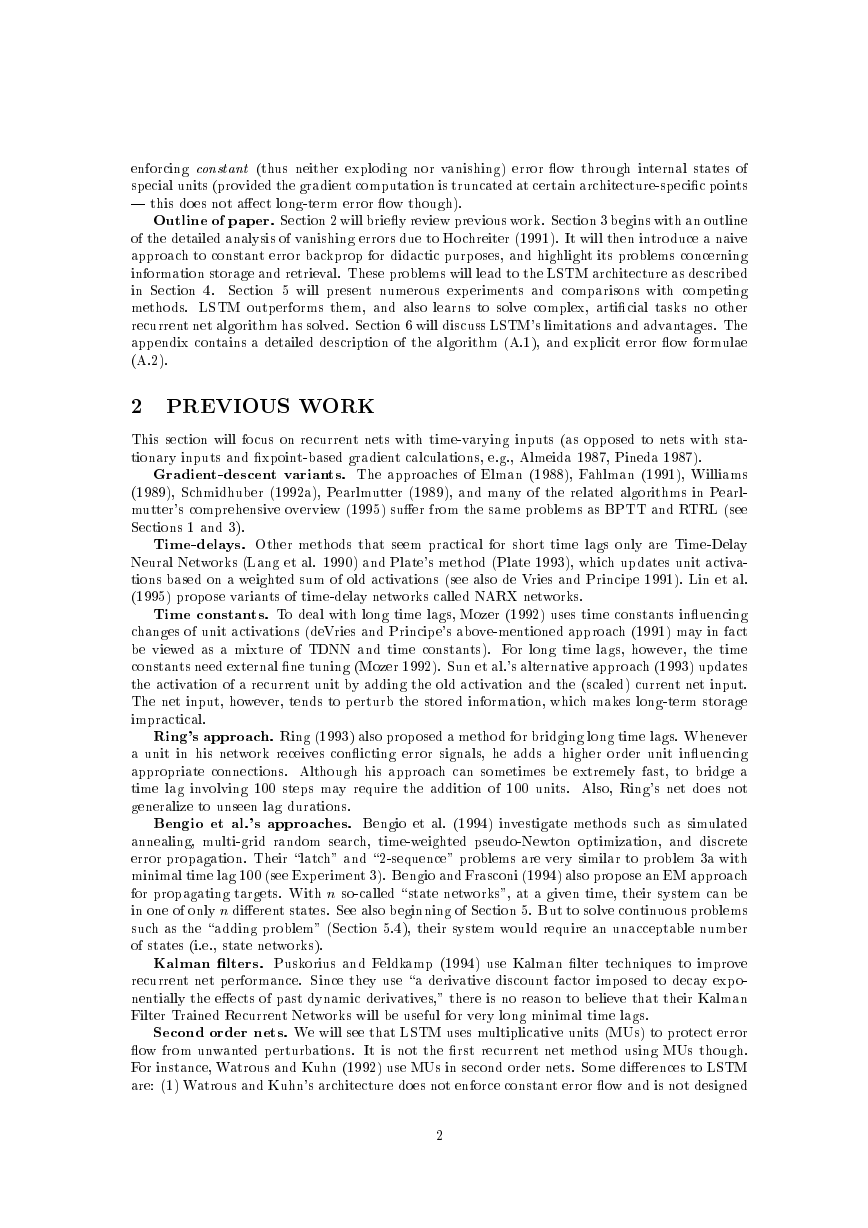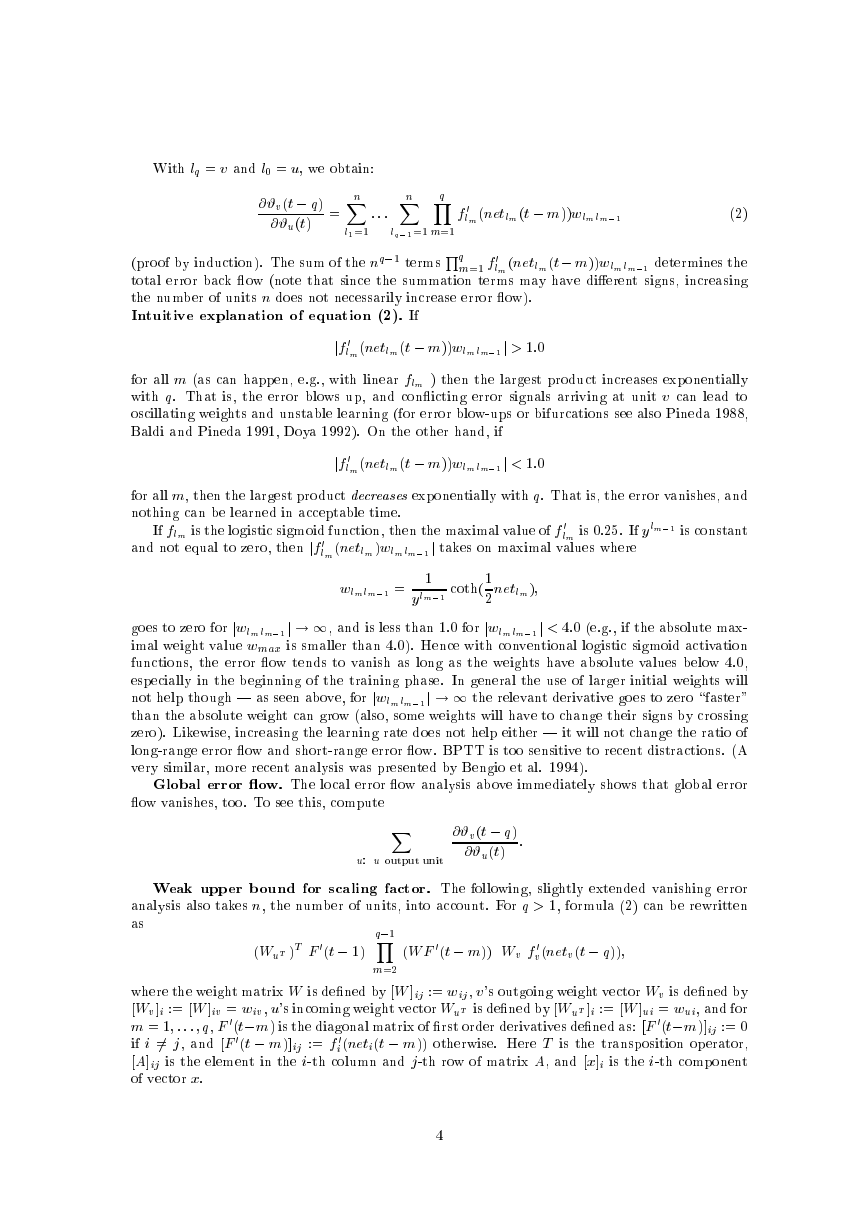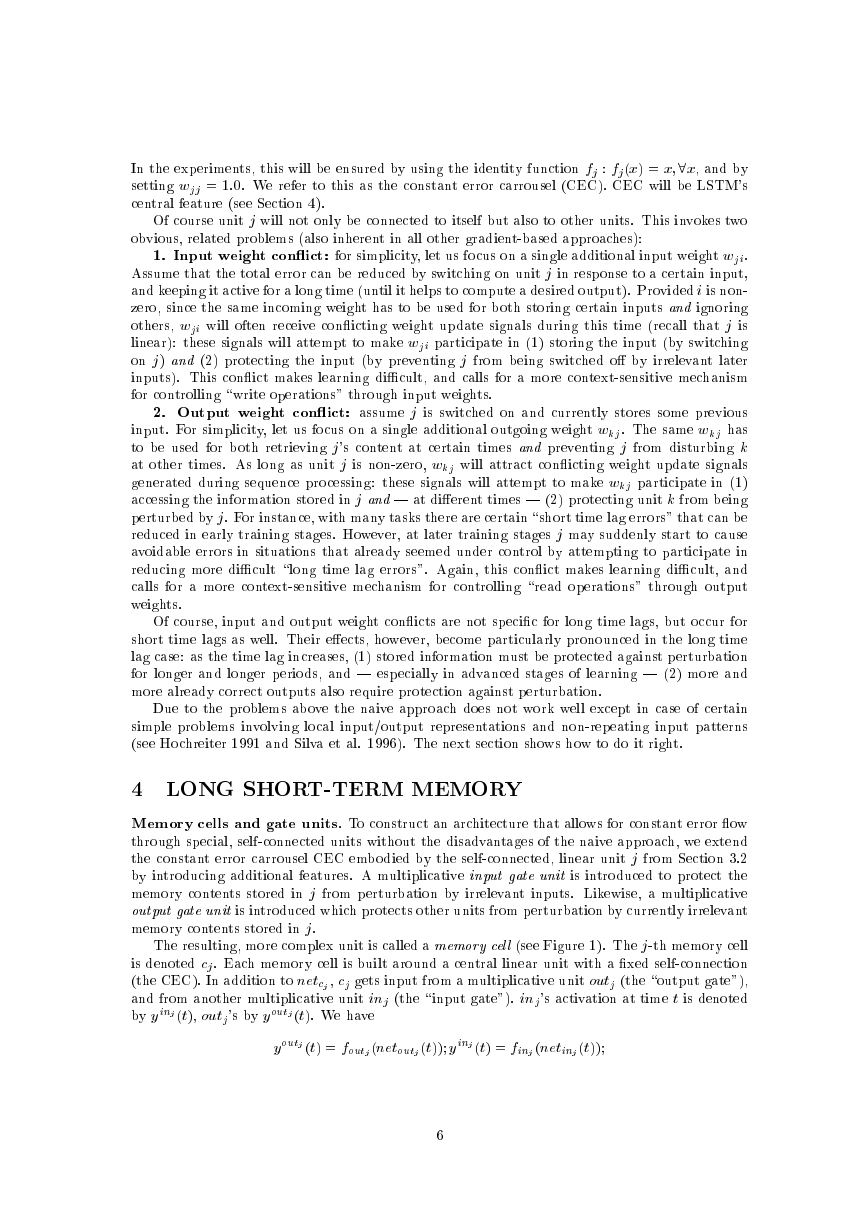See discussions, stats, and author profiles for this publication at: https://www.researchgate.net/publication/13853244
Long Short-term Memory
Article in Neural Computation · December 1997
DOI: 10.1162/neco.1997.9.8.1735 · Source: PubMed
CITATIONS
3,842
2 authors, including:
READS
12,549
Sepp Hochreiter
Johannes Kepler University Linz
132 PUBLICATIONS 5,945 CITATIONS
SEE PROFILE
Some of the authors of this publication are also working on these related projects:
IBD Sharing between Africans, Neandertals, and Denisovans View project
Self-Normalizing Neural Networks View project
All content following this page was uploaded by Sepp Hochreiter on 03 April 2016.
The user has requested enhancement of the downloaded file.
�
LONGSHORT-TERMMEMORY
NeuralComputation (�):����{����,� �
JurgenSchmidhuber
SeppHochreiter
IDSIA
FakultatfurInformatik
CorsoElvezia��
TechnischeUniversitatMunchen
� ��Lugano,Switzerland
��� �Munchen,Germany
juergen@idsia.ch
hochreit@informatik.tu-muenchen.de
http://www.idsia.ch/~juergen
http://www�.informatik.tu-muenchen.de/~hochreit
Abstract
Learningtostoreinformationoverextendedtimeintervalsviarecurrentbackpropagation
takesaverylongtime,mostlyduetoinsucient,decayingerrorbackow.Webrieyreview
Hochreiter's� �analysisofthisproblem,thenaddressitbyintroducinganovel,ecient,
gradient-basedmethodcalled\LongShort-TermMemory"(LSTM).Truncatingthegradient
wherethisdoesnotdoharm,LSTMcanlearntobridgeminimaltimelagsinexcessof����
discretetimestepsbyenforcingconstanterrorowthrough\constanterrorcarrousels"within
specialunits.Multiplicativegateunitslearntoopenandcloseaccesstotheconstanterror
ow.LSTMislocalinspaceandtime;itscomputationalcomplexitypertimestepandweight
isO(�).Ourexperimentswitharticialdatainvolvelocal,distributed,real-valued,andnoisy
patternrepresentations.IncomparisonswithRTRL,BPTT,RecurrentCascade-Correlation,
Elmannets,andNeuralSequenceChunking,LSTMleadstomanymoresuccessfulruns,and
learnsmuchfaster.LSTMalsosolvescomplex,articiallongtimelagtasksthathavenever
beensolvedbypreviousrecurrentnetworkalgorithms.
INTRODUCTION
�
Recurrentnetworkscaninprincipleusetheirfeedbackconnectionstostorerepresentationsof
recentinputeventsinformofactivations(\short-termmemory",asopposedto\long-termmem-
ory"embodiedbyslowlychangingweights).Thisispotentiallysignicantformanyapplications,
includingspeechprocessing,non-Markoviancontrol,andmusiccomposition(e.g.,Mozer� �).
Themostwidelyusedalgorithmsforlearningwhattoputinshort-termmemory,however,take
toomuchtimeordonotworkwellatall,especiallywhenminimaltimelagsbetweeninputsand
correspondingteachersignalsarelong.Althoughtheoreticallyfascinating,existingmethodsdo
notprovideclearpracticaladvantagesover,say,backpropinfeedforwardnetswithlimitedtime
windows.Thispaperwillreviewananalysisoftheproblemandsuggestaremedy.
Theproblem.Withconventional\Back-PropagationThroughTime"(BPTT,e.g.,Williams
andZipser� �,Werbos� ��)or\Real-TimeRecurrentLearning"(RTRL,e.g.,Robinsonand
Fallside� ��),errorsignals\owingbackwardsintime"tendtoeither(�)blowupor(�)vanish:
thetemporalevolutionofthebackpropagatederrorexponentiallydependsonthesizeofthe
weights(Hochreiter� �).Case(�)mayleadtooscillatingweights,whileincase(�)learningto
bridgelongtimelagstakesaprohibitiveamountoftime,ordoesnotworkatall(seesection�).
Theremedy.Thispaperpresents\LongShort-TermMemory"(LSTM),anovelrecurrent
networkarchitectureinconjunctionwithanappropriategradient-basedlearningalgorithm.LSTM
isdesignedtoovercometheseerrorback-owproblems.Itcanlearntobridgetimeintervalsin
excessof����stepsevenincaseofnoisy,incompressibleinputsequences,withoutlossofshort
timelagcapabilities.Thisisachievedbyanecient,gradient-basedalgorithmforanarchitecture
�
�
enforcingconstant(thusneitherexplodingnorvanishing)errorowthroughinternalstatesof
specialunits(providedthegradientcomputationistruncatedatcertainarchitecture-specicpoints
|thisdoesnotaectlong-termerrorowthough).
Outlineofpaper.Section�willbrieyreviewpreviouswork.Section�beginswithanoutline
ofthedetailedanalysisofvanishingerrorsduetoHochreiter(� �).Itwillthenintroduceanaive
approachtoconstanterrorbackpropfordidacticpurposes,andhighlightitsproblemsconcerning
informationstorageandretrieval.TheseproblemswillleadtotheLSTMarchitectureasdescribed
inSection�.Section�willpresentnumerousexperimentsandcomparisonswithcompeting
methods.LSTMoutperformsthem,andalsolearnstosolvecomplex,articialtasksnoother
recurrentnetalgorithmhassolved.Section�willdiscussLSTM'slimitationsandadvantages.The
appendixcontainsadetaileddescriptionofthealgorithm(A.�),andexpliciterrorowformulae
(A.�).� PREVIOUSWORK
Thissectionwillfocusonrecurrentnetswithtime-varyinginputs(asopposedtonetswithsta-
tionaryinputsandxpoint-basedgradientcalculations,e.g.,Almeida� ��,Pineda� ��).
Gradient-descentvariants.TheapproachesofElman(� ��),Fahlman(� �),Williams
(� � ),Schmidhuber(� �a),Pearlmutter(� � ),andmanyoftherelatedalgorithmsinPearl-
mutter'scomprehensiveoverview(� �)suerfromthesameproblemsasBPTTandRTRL(see
Sections�and�).
Time-delays.OthermethodsthatseempracticalforshorttimelagsonlyareTime-Delay
NeuralNetworks(Langetal.� �)andPlate'smethod(Plate� �),whichupdatesunitactiva-
tionsbasedonaweightedsumofoldactivations(seealsodeVriesandPrincipe� �).Linetal.
(� �)proposevariantsoftime-delaynetworkscalledNARXnetworks.
Timeconstants.Todealwithlongtimelags,Mozer(� �)usestimeconstantsinuencing
changesofunitactivations(deVriesandPrincipe'sabove-mentionedapproach(� �)mayinfact
beviewedasamixtureofTDNNandtimeconstants).Forlongtimelags,however,thetime
constantsneedexternalnetuning(Mozer� �).Sunetal.'salternativeapproach(� �)updates
theactivationofarecurrentunitbyaddingtheoldactivationandthe(scaled)currentnetinput.
Thenetinput,however,tendstoperturbthestoredinformation,whichmakeslong-termstorage
impractical.
Ring'sapproach.Ring(� �)alsoproposedamethodforbridginglongtimelags.Whenever
aunitinhisnetworkreceivesconictingerrorsignals,headdsahigherorderunitinuencing
appropriateconnections.Althoughhisapproachcansometimesbeextremelyfast,tobridgea
timelaginvolving���stepsmayrequiretheadditionof���units.Also,Ring'snetdoesnot
generalizetounseenlagdurations.
Bengioetal.'sapproaches.Bengioetal.(� �)investigatemethodssuchassimulated
annealing,multi-gridrandomsearch,time-weightedpseudo-Newtonoptimization,anddiscrete
errorpropagation.Their\latch"and\�-sequence"problemsareverysimilartoproblem�awith
minimaltimelag���(seeExperiment�).BengioandFrasconi(� �)alsoproposeanEMapproach
forpropagatingtargets.Withnso-called\statenetworks",atagiventime,theirsystemcanbe
inoneofonlyndierentstates.SeealsobeginningofSection�.Buttosolvecontinuousproblems
suchasthe\addingproblem"(Section�.�),theirsystemwouldrequireanunacceptablenumber
ofstates(i.e.,statenetworks).
Kalmanlters.PuskoriusandFeldkamp(� �)useKalmanltertechniquestoimprove
recurrentnetperformance.Sincetheyuse\aderivativediscountfactorimposedtodecayexpo-
nentiallytheeectsofpastdynamicderivatives,"thereisnoreasontobelievethattheirKalman
FilterTrainedRecurrentNetworkswillbeusefulforverylongminimaltimelags.
Secondordernets.WewillseethatLSTMusesmultiplicativeunits(MUs)toprotecterror
owfromunwantedperturbations.ItisnottherstrecurrentnetmethodusingMUsthough.
Forinstance,WatrousandKuhn(� �)useMUsinsecondordernets.SomedierencestoLSTM
are:(�)WatrousandKuhn'sarchitecturedoesnotenforceconstanterrorowandisnotdesigned
�
�
tosolvelongtimelagproblems.(�)Ithasfullyconnectedsecond-ordersigma-piunits,whilethe
LSTMarchitecture'sMUsareusedonlytogateaccesstoconstanterrorow.(�)Watrousand
Kuhn'salgorithmcostsO(W�)operationspertimestep,oursonlyO(W),whereWisthenumber
ofweights.SeealsoMillerandGiles(� �)foradditionalworkonMUs.
Simpleweightguessing.Toavoidlongtimelagproblemsofgradient-basedapproacheswe
maysimplyrandomlyinitializeallnetworkweightsuntiltheresultingnethappenstoclassifyall
trainingsequencescorrectly.Infact,recentlywediscovered(SchmidhuberandHochreiter� �,
HochreiterandSchmidhuber� �,� �)thatsimpleweightguessingsolvesmanyoftheproblems
in(Bengio� �,BengioandFrasconi� �,MillerandGiles� �,Linetal.� �)fasterthan
thealgorithmsproposedtherein.Thisdoesnotmeanthatweightguessingisagoodalgorithm.
Itjustmeansthattheproblemsareverysimple.Morerealistictasksrequireeithermanyfree
parameters(e.g.,inputweights)orhighweightprecision(e.g.,forcontinuous-valuedparameters),
suchthatguessingbecomescompletelyinfeasible.
Adaptivesequencechunkers.Schmidhuber'shierarchicalchunkersystems(� �b,� �)
dohaveacapabilitytobridgearbitrarytimelags,butonlyifthereislocalpredictabilityacrossthe
subsequencescausingthetimelags(seealsoMozer� �).Forinstance,inhispostdoctoralthesis
(� �),Schmidhuberuseshierarchicalrecurrentnetstorapidlysolvecertaingrammarlearning
tasksinvolvingminimaltimelagsinexcessof����steps.Theperformanceofchunkersystems,
however,deterioratesasthenoiselevelincreasesandtheinputsequencesbecomelesscompressible.
LSTMdoesnotsuerfromthisproblem.
� CONSTANTERRORBACKPROP
�.� EXPONENTIALLYDECAYINGERROR
ConventionalBPTT(e.g.WilliamsandZipser� �).Outputunitk'stargetattimetis
denotedbydk(t).Usingmeansquarederror,k'serrorsignalis
#k(t)=f�k(netk(t))(dk(t)yk(t));
where
yi(t)=fi(neti(t))
istheactivationofanon-inputunitiwithdierentiableactivationfunctionfi,
neti(t)=Xjwijyj(t�)
isuniti'scurrentnetinput,andwijistheweightontheconnectionfromunitjtoi.Some
non-outputunitj'sbackpropagatederrorsignalis
#j(t)=f�j(netj(t))Xiwij#i(t+�):
Thecorrespondingcontributiontowjl'stotalweightupdateis#j(t)yl(t�),whereisthe
learningrate,andlstandsforanarbitraryunitconnectedtounitj.
OutlineofHochreiter'sanalysis(� �,page� -��).Supposewehaveafullyconnected
netwhosenon-inputunitindicesrangefrom�ton.Letusfocusonlocalerrorowfromunitu
tounitv(laterwewillseethattheanalysisimmediatelyextendstoglobalerrorow).Theerror
occurringatanarbitraryunituattimesteptispropagated\backintotime"forqtimesteps,to
anarbitraryunitv.Thiswillscaletheerrorbythefollowingfactor:
@#u(t) =(
f�v(netv(t�))wuv
@#v(tq)
f�v(netv(tq))Pnl=�@#l(tq+�)
(�)
@#u(t)wlv
�
q=�
q>�:
�
Withlq=vandl�=u,weobtain:
qYm=�f�lm(netlm(tm))wlmlm�
@#u(t) =nXl�=�:::
nXlq�=�
@#v(tq)
(�)
(proofbyinduction).Thesumofthenq�termsQqm=�f�lm(netlm(tm))wlmlm�determinesthe
totalerrorbackow(notethatsincethesummationtermsmayhavedierentsigns,increasing
thenumberofunitsndoesnotnecessarilyincreaseerrorow).
Intuitiveexplanationofequation(�).If
jf�lm(netlm(tm))wlmlm�j>�:�
forallm(ascanhappen,e.g.,withlinearflm)thenthelargestproductincreasesexponentially
withq.Thatis,theerrorblowsup,andconictingerrorsignalsarrivingatunitvcanleadto
oscillatingweightsandunstablelearning(forerrorblow-upsorbifurcationsseealsoPineda� ��,
BaldiandPineda� �,Doya� �).Ontheotherhand,if
jf�lm(netlm(tm))wlmlm�j<�:�
forallm,thenthelargestproductdecreasesexponentiallywithq.Thatis,theerrorvanishes,and
nothingcanbelearnedinacceptabletime.
Ifflmisthelogisticsigmoidfunction,thenthemaximalvalueoff�lmis�.��.Ifylm�isconstant
andnotequaltozero,thenjf�lm(netlm)wlmlm�jtakesonmaximalvalueswhere
wlmlm�= �ylm�coth(��netlm);
goestozeroforjwlmlm�j!�,andislessthan�:�forjwlmlm�j<�:�(e.g.,iftheabsolutemax-
imalweightvaluewmaxissmallerthan�.�).Hencewithconventionallogisticsigmoidactivation
functions,theerrorowtendstovanishaslongastheweightshaveabsolutevaluesbelow�.�,
especiallyinthebeginningofthetrainingphase.Ingeneraltheuseoflargerinitialweightswill
nothelpthough|asseenabove,forjwlmlm�j!�therelevantderivativegoestozero\faster"
thantheabsoluteweightcangrow(also,someweightswillhavetochangetheirsignsbycrossing
zero).Likewise,increasingthelearningratedoesnothelpeither|itwillnotchangetheratioof
long-rangeerrorowandshort-rangeerrorow.BPTTistoosensitivetorecentdistractions.(A
verysimilar,morerecentanalysiswaspresentedbyBengioetal.� �).
Globalerrorow.Thelocalerrorowanalysisaboveimmediatelyshowsthatglobalerror
owvanishes,too.Toseethis,computeXu:uoutputunit@#v(tq)
:
@#u(t)
Weakupperboundforscalingfactor.Thefollowing,slightlyextendedvanishingerror
analysisalsotakesn,thenumberofunits,intoaccount.Forq>�,formula(�)canberewritten
as
(WuT)TF�(t�)q�Ym=�(WF�(tm))Wvf�v(netv(tq));
wheretheweightmatrixWisdenedby[W]ij:=wij,v'soutgoingweightvectorWvisdenedby
[Wv]i:=[W]iv=wiv,u'sincomingweightvectorWuTisdenedby[WuT]i:=[W]ui=wui,andfor
m=�;:::;q,F�(tm)isthediagonalmatrixofrstorderderivativesdenedas:[F�(tm)]ij:=�
ifi�=j,and[F�(tm)]ij:=f�i(neti(tm))otherwise.HereTisthetranspositionoperator,
[A]ijistheelementinthei-thcolumnandj-throwofmatrixA,and[x]iisthei-thcomponent
ofvectorx.
�
�
Usingamatrixnormk:kAcompatiblewithvectornormk:kx,wedene
f�max:=maxm=�;:::;qfkF�(tm)kAg:
Formaxi=�;:::;nfjxijgkxkxwegetjxTyjnkxkxkykx:Since
jf�v(netv(tq))jkF�(tq)kAf�max;
weobtainthefollowinginequality:
j@#v(tq)
jn(f�max)qkWvkxkWuTkxkWkq�A n(f�maxkWkA)q:
@#u(t)
ThisinequalityresultsfromkWvkx=kWevkxkWkAkevkxkWkA
and
kWuTkx=keuWkxkWkAkeukxkWkA;
whereekistheunitvectorwhosecomponentsare�exceptforthek-thcomponent,whichis�.
Notethatthisisaweak,extremecaseupperbound|itwillbereachedonlyifallkF�(tm)kA
takeonmaximalvalues,andifthecontributionsofallpathsacrosswhicherrorowsbackfrom
unitutounitvhavethesamesign.LargekWkA,however,typicallyresultinsmallvaluesof
kF�(tm)kA,asconrmedbyexperiments(see,e.g.,Hochreiter� �).
Forexample,withnorms
kWkA:=maxrXsjwrsj
and
kxkx:=maxrjxrj;
wehavef�max=�:��forthelogisticsigmoid.Weobservethatif
jwijjwmax<�:�n�i;j;
thenkWkAnwmax<�:�willresultinexponentialdecay|bysetting:=nwmax
�:�<�:�,
weobtain
j@#v(tq)
jn()q:
@#u(t)
WerefertoHochreiter's� �thesisforadditionalresults.
�.� CONSTANTERRORFLOW:NAIVEAPPROACH
Asingleunit.Toavoidvanishingerrorsignals,howcanweachieveconstanterrorowthrough
asingleunitjwithasingleconnectiontoitself?Accordingtotherulesabove,attimet,j'slocal
errorbackowis#j(t)=f�j(netj(t))#j(t+�)wjj.Toenforceconstanterrorowthroughj,we
require
f�j(netj(t))wjj=�:�:
NotethesimilaritytoMozer'sxedtimeconstantsystem(� �)|atimeconstantof�:�is
appropriateforpotentiallyinnitetimelags�.
Theconstanterrorcarrousel.
Integratingthedierentialequationabove,weobtain
fj(netj(t))=netj(t)wjj
forarbitrarynetj(t).Thismeans:fjhastobelinear,andunitj'sacti-
vationhastoremainconstant:
yj(t+�)=fj(netj(t+�))=fj(wjjyj(t))=yj(t):
�Wedonotusetheexpression\timeconstant"inthedierentialsense,as,e.g.,Pearlmutter(� �).
�
�
Intheexperiments,thiswillbeensuredbyusingtheidentityfunctionfj:fj(x)=x;�x,andby
settingwjj=�:�.Werefertothisastheconstanterrorcarrousel(CEC).CECwillbeLSTM's
centralfeature(seeSection�).
Ofcourseunitjwillnotonlybeconnectedtoitselfbutalsotootherunits.Thisinvokestwo
obvious,relatedproblems(alsoinherentinallothergradient-basedapproaches):
�.Inputweightconict:forsimplicity,letusfocusonasingleadditionalinputweightwji.
Assumethatthetotalerrorcanbereducedbyswitchingonunitjinresponsetoacertaininput,
andkeepingitactiveforalongtime(untilithelpstocomputeadesiredoutput).Providediisnon-
zero,sincethesameincomingweighthastobeusedforbothstoringcertaininputsandignoring
others,wjiwilloftenreceiveconictingweightupdatesignalsduringthistime(recallthatjis
linear):thesesignalswillattempttomakewjiparticipatein(�)storingtheinput(byswitching
onj)and(�)protectingtheinput(bypreventingjfrombeingswitchedobyirrelevantlater
inputs).Thisconictmakeslearningdicult,andcallsforamorecontext-sensitivemechanism
forcontrolling\writeoperations"throughinputweights.
�.Outputweightconict:assumejisswitchedonandcurrentlystoressomeprevious
input.Forsimplicity,letusfocusonasingleadditionaloutgoingweightwkj.Thesamewkjhas
tobeusedforbothretrievingj'scontentatcertaintimesandpreventingjfromdisturbingk
atothertimes.Aslongasunitjisnon-zero,wkjwillattractconictingweightupdatesignals
generatedduringsequenceprocessing:thesesignalswillattempttomakewkjparticipatein(�)
accessingtheinformationstoredinjand|atdierenttimes|(�)protectingunitkfrombeing
perturbedbyj.Forinstance,withmanytaskstherearecertain\shorttimelagerrors"thatcanbe
reducedinearlytrainingstages.However,atlatertrainingstagesjmaysuddenlystarttocause
avoidableerrorsinsituationsthatalreadyseemedundercontrolbyattemptingtoparticipatein
reducingmoredicult\longtimelagerrors".Again,thisconictmakeslearningdicult,and
callsforamorecontext-sensitivemechanismforcontrolling\readoperations"throughoutput
weights.Ofcourse,inputandoutputweightconictsarenotspecicforlongtimelags,butoccurfor
shorttimelagsaswell.Theireects,however,becomeparticularlypronouncedinthelongtime
lagcase:asthetimelagincreases,(�)storedinformationmustbeprotectedagainstperturbation
forlongerandlongerperiods,and|especiallyinadvancedstagesoflearning|(�)moreand
morealreadycorrectoutputsalsorequireprotectionagainstperturbation.
Duetotheproblemsabovethenaiveapproachdoesnotworkwellexceptincaseofcertain
simpleproblemsinvolvinglocalinput/outputrepresentationsandnon-repeatinginputpatterns
(seeHochreiter� �andSilvaetal.� �).Thenextsectionshowshowtodoitright.
� LONGSHORT-TERMMEMORY
Memorycellsandgateunits.Toconstructanarchitecturethatallowsforconstanterrorow
throughspecial,self-connectedunitswithoutthedisadvantagesofthenaiveapproach,weextend
theconstanterrorcarrouselCECembodiedbytheself-connected,linearunitjfromSection�.�
byintroducingadditionalfeatures.Amultiplicativeinputgateunitisintroducedtoprotectthe
memorycontentsstoredinjfromperturbationbyirrelevantinputs.Likewise,amultiplicative
outputgateunitisintroducedwhichprotectsotherunitsfromperturbationbycurrentlyirrelevant
memorycontentsstoredinj.
Theresulting,morecomplexunitiscalledamemorycell(seeFigure�).Thej-thmemorycell
isdenotedcj.Eachmemorycellisbuiltaroundacentrallinearunitwithaxedself-connection
(theCEC).Inadditiontonetcj,cjgetsinputfromamultiplicativeunitoutj(the\outputgate"),
andfromanothermultiplicativeunitinj(the\inputgate").inj'sactivationattimetisdenoted
byyinj(t),outj'sbyyoutj(t).Wehave
youtj(t)=foutj(netoutj(t));yinj(t)=finj(netinj(t));
�
�
where
netoutj(t)=Xuwoutjuyu(t�);
and
netinj(t)=Xuwinjuyu(t�):
Wealsohave
netcj(t)=Xuwcjuyu(t�):
Thesummationindicesumaystandforinputunits,gateunits,memorycells,orevenconventional
hiddenunitsifthereareany(seealsoparagraphon\networktopology"below).Allthesedierent
typesofunitsmayconveyusefulinformationaboutthecurrentstateofthenet.Forinstance,
aninputgate(outputgate)mayuseinputsfromothermemorycellstodecidewhethertostore
(access)certaininformationinitsmemorycell.Thereevenmayberecurrentself-connectionslike
wcjcj.Itisuptotheusertodenethenetworktopology.SeeFigure�foranexample.
Attimet,cj'soutputycj(t)iscomputedas
ycj(t)=youtj(t)h(scj(t));
wherethe\internalstate"scj(t)is
scj(�)=�;scj(t)=scj(t�)+yinj(t)gnetcj(t)fort>�:
Thedierentiablefunctiongsquashesnetcj;thedierentiablefunctionhscalesmemorycell
outputscomputedfromtheinternalstatescj.
net c j
s c j
g
g y inj
g+
=
s c j
1.0
y inj
h
y c j
h y out j
y out j
net
inj
w ic j
w i
inj
w i
out j
Figure�:Architectureofmemorycellcj(thebox)anditsgateunitsinj;outj.Theself-recurrent
connection(withweight�.�)indicatesfeedbackwithadelayof�timestep.Itbuildsthebasisof
the\constanterrorcarrousel"CEC.ThegateunitsopenandcloseaccesstoCEC.Seetextand
appendixA.�fordetails.
Whygateunits?Toavoidinputweightconicts,injcontrolstheerrorowtomemorycell
cj'sinputconnectionswcji.Tocircumventcj'soutputweightconicts,outjcontrolstheerror
owfromunitj'soutputconnections.Inotherwords,thenetcanuseinjtodecidewhentokeep
oroverrideinformationinmemorycellcj,andoutjtodecidewhentoaccessmemorycellcjand
whentopreventotherunitsfrombeingperturbedbycj(seeFigure�).
Errorsignalstrappedwithinamemorycell'sCECcannotchange{butdierenterrorsignals
owingintothecell(atdierenttimes)viaitsoutputgatemaygetsuperimposed.Theoutput
gatewillhavetolearnwhicherrorstotrapinitsCEC,byappropriatelyscalingthem.Theinput
y inj
wi c j
net
out j
�
�
















 2023年江西萍乡中考道德与法治真题及答案.doc
2023年江西萍乡中考道德与法治真题及答案.doc 2012年重庆南川中考生物真题及答案.doc
2012年重庆南川中考生物真题及答案.doc 2013年江西师范大学地理学综合及文艺理论基础考研真题.doc
2013年江西师范大学地理学综合及文艺理论基础考研真题.doc 2020年四川甘孜小升初语文真题及答案I卷.doc
2020年四川甘孜小升初语文真题及答案I卷.doc 2020年注册岩土工程师专业基础考试真题及答案.doc
2020年注册岩土工程师专业基础考试真题及答案.doc 2023-2024学年福建省厦门市九年级上学期数学月考试题及答案.doc
2023-2024学年福建省厦门市九年级上学期数学月考试题及答案.doc 2021-2022学年辽宁省沈阳市大东区九年级上学期语文期末试题及答案.doc
2021-2022学年辽宁省沈阳市大东区九年级上学期语文期末试题及答案.doc 2022-2023学年北京东城区初三第一学期物理期末试卷及答案.doc
2022-2023学年北京东城区初三第一学期物理期末试卷及答案.doc 2018上半年江西教师资格初中地理学科知识与教学能力真题及答案.doc
2018上半年江西教师资格初中地理学科知识与教学能力真题及答案.doc 2012年河北国家公务员申论考试真题及答案-省级.doc
2012年河北国家公务员申论考试真题及答案-省级.doc 2020-2021学年江苏省扬州市江都区邵樊片九年级上学期数学第一次质量检测试题及答案.doc
2020-2021学年江苏省扬州市江都区邵樊片九年级上学期数学第一次质量检测试题及答案.doc 2022下半年黑龙江教师资格证中学综合素质真题及答案.doc
2022下半年黑龙江教师资格证中学综合素质真题及答案.doc